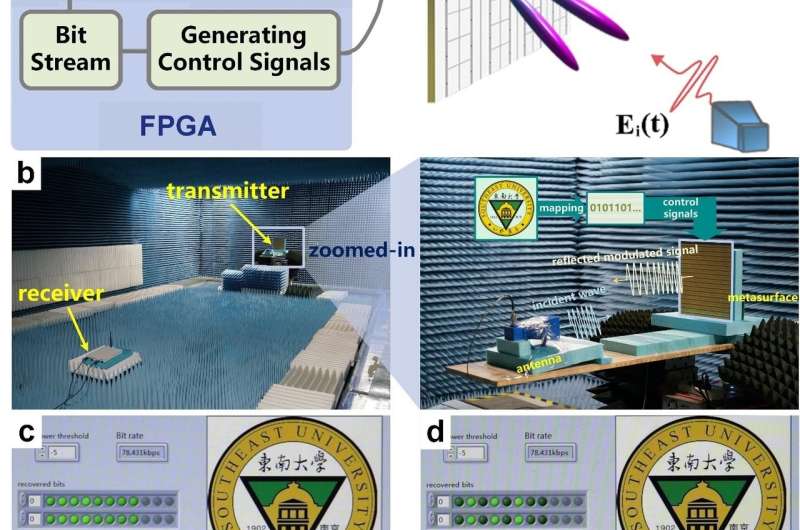Tailoring nonlinearity with time domain metasurface for wireless communication

Electromagnetic and optical nonlinear effects provide an important platform in a broad spectrum of technologies, including high harmonic generation, sum and difference frequency conversions, self-focusing, optical solitons, and multi-photon absorption. When illuminated by high light intensity, the material properties are modified depending on the applied electromagnetic field amplitudes, and the nonlinear process is greatly enhanced during the interaction between light and materials, giving rise to spectral components at new frequencies. Although tremendous advances for nonlinear manipulations have been achieved in recent years, the overall efficiency of the frequency conversion still remains very low.
Metamaterials, which are usually constituted by spatially distributed periodic or non-periodic array of subwavelength resonators, have been demonstrated as a powerful tool to alter the responses of incident electromagnetic waves. By optimizing the element geometries and their spatial alignments, the metamaterials are easy to create highly customizable properties that can be exploited in a wide variety of applications like super-resolution imaging, optical cloaking, and novel antennas. The nonlinear characteristics of metamaterials have displayed emerging potentials for frequency conversions owing to the induced local fields around the resonators. However, the conversion ratio is not satisfactory especially under the excitation of small signals.
In a new paper published in the Beijing-based National Science Review, scientists at the State Key Laboratory of Millimeter Waves in Nanjing, China, the National Mobile Communication Research Laboratory in Nanjing, China, and the Photonics Initiative, Advanced Science Research Center in New York, US, present the latest advances in the nonlinear harmonic manipulation with a programmable time-domain digital coding metasurface. They find that the metasurface with time varying reflectivity can respond to the excitation carrier nonlinearly in a strong way, with the harmonic intensity dependent on the digital coding sequence of the reflection amplitude and phase.
These scientists summarize the details of the theory and design method of the metasurface, and the future application of this technology.
The authors write, "Inspired by space-domain digital coding metasurfaces, we employ complex modulation strategies to tailor the wave-matter interactions and frequency spectrum simultaneously, in which the discrete reflection phase states of the metasurface are controlled by the digital coding sequence. We demonstrate that strong nonlinear processes are enabled by the temporal modulation of incident waves on the metasurface with accurate controls of both amplitude and phase distributions for all harmonics."
The metasurface is composed of periodic coding elements loaded with varactor diodes. "Driven by different combinations of output voltages from a field programmable gate array (FPGA), our metasurface can implement many functions by controlling the time-domain digital coding states," they write.
"As an example of applications, we explore the implementation of a new binary frequency-shift keying (BFSK) wireless communication system, which highly simplifies the classical heterodyne architectures for wireless network systems. In the proposed BFSK system, the two basic carrier frequencies are synthesized directly via the metasurface, without using complicated analog-digital converter and microwave filters, mixers, and amplifiers, showing great advantages in terms of simplicity and efficiency," they add.
"The proposed concept and method pave a way for simplified and compact communication and radar systems for a wide frequency range, from acoustic to microwaves and optics," the scientists forecast.
The calculated spectral intensities of the output harmonics under different PM modulations. (a-b), 1-bit PM coding 01010101... with the length of the coding sequence M=2 and the reflection period T=1μs. (c-d), 2-bit PM coding 00-01-00-01-... with M=2 and T=1μs. (e-f), 2-bit PM coding 00-01-10-11-... with M=4 and T=2μs. g-h, 2-bit PM coding 11-10-01-00-... with M=4 and T=2μs.
More information: Jie Zhao et al, Programmable time-domain digital coding metasurface for nonlinear harmonic manipulation and new wireless communication systems, National Science Review (2018). DOI: 10.1093/nsr/nwy135
Provided by Science China Press




















